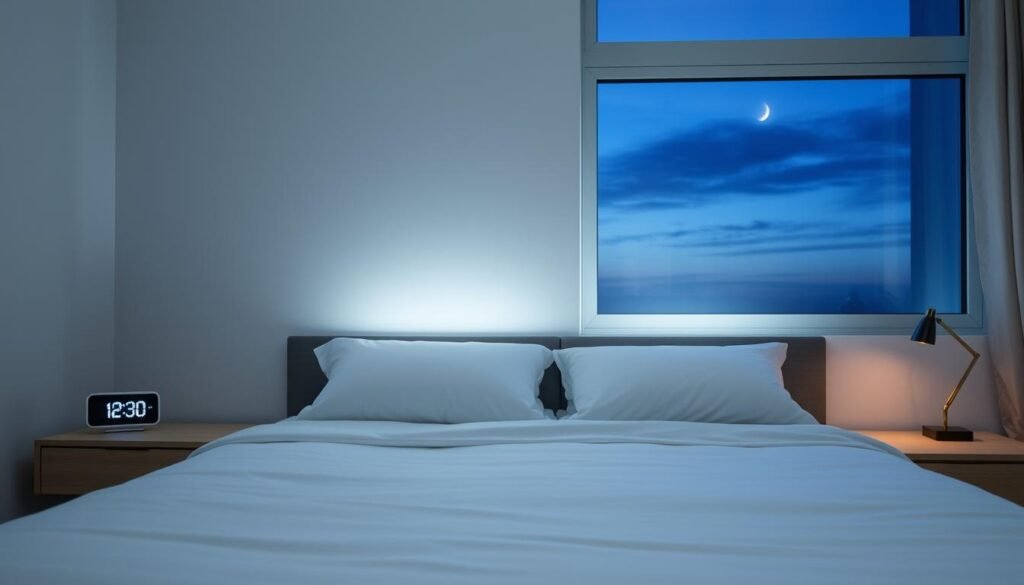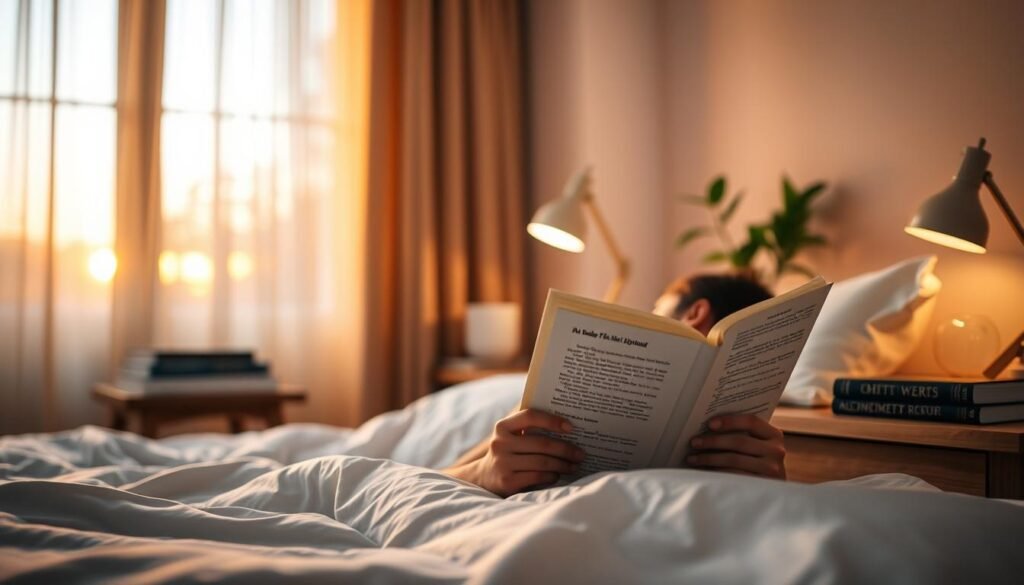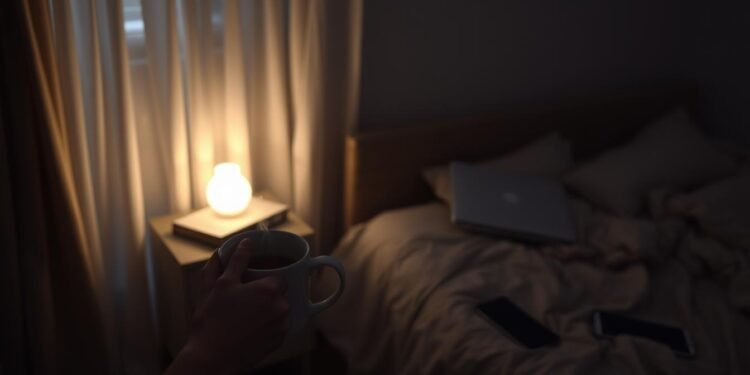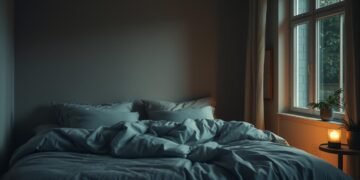Have you ever wondered why falling asleep feels like a battle? In the U.S., 14.5% of adults struggle with sleep onset. Our modern lifestyle, filled with screens and caffeine, often disrupts our natural ability to rest. Sleep isn’t instant—it’s a gradual process that requires preparation.
Creating a consistent routine can bridge the gap between daytime activity and restorative sleep. Studies show that those with regular habits fall asleep 45% faster. Beyond physical recovery, these practices also support mental health, helping our minds process emotions effectively.
In this article, we’ll explore science-backed strategies to manage light, time caffeine intake, and reduce screen exposure. These small changes can make a big difference in helping your body and mind prepare for restful sleep.
Key Takeaways
- Modern habits like screen use and caffeine can disrupt sleep.
- Sleep is a gradual process that requires preparation.
- Consistent routines can speed up sleep onset by 45%.
- Routines benefit both physical recovery and emotional processing.
- Science-backed strategies include light management and digital detox.
Why a Bedtime Wind-Down Routine Matters
What if small changes in your evening could transform your sleep? A consistent routine helps your body and mind transition from the day’s activities to restful sleep. It’s not just about feeling tired—it’s about preparing your system for recovery.
The Science Behind Winding Down
When we follow predictable evening patterns, our cortisol levels drop. This stress hormone decreases as our brain recognizes it’s time to relax. Studies show that consistent pre-sleep rituals can speed up sleep onset by 33%.
Our neurochemistry also shifts. The sympathetic nervous system, responsible for alertness, gives way to the parasympathetic system, which promotes calm. This transition is essential for health and well-being.
How Routines Signal Your Brain for Sleep
Our brains thrive on patterns. Simple actions like brushing your teeth or changing into pajamas act as cues. These sequences tell your body it’s time to wind down. Research from Sleepstation highlights that routine consistency improves sleep maintenance.
Planning for the next day can also reduce nighttime stress. Writing down tasks or goals can improve sleep quality by 27%. By creating a structured evening, you’re setting the stage for deeper, more restorative rest.
The Role of Light in Your Bedtime Routine
Light plays a crucial role in how well we sleep. It influences our internal clock, known as the circadian rhythm, which regulates sleep and wake cycles. The type of light we’re exposed to in the evening can either help or hinder our ability to rest.
How Blue Light Affects Sleep
Blue light, emitted by screens and energy-efficient bulbs, is particularly disruptive. It suppresses melatonin, the hormone that signals sleep, by up to 50%. This can delay sleep onset and reduce sleep quality.
Red and amber wavelengths, on the other hand, promote relaxation. Studies show that amber lighting increases melatonin production by 35%, making it a better choice for evening use.
Tips for Reducing Light Exposure Before Bed
To minimize the impact of blue light, consider using apps like F.lux or Night Shift on your devices. Activate these features 3 hours bed to reduce eye strain and prepare your body for sleep.
Smart bulbs can also help. Program them to gradually dim in the evening, mimicking sunset. For complete darkness, invest in blackout curtains or an adjustable eye mask.
If you’re sensitive to light, set device cutoffs at 15, 30, or 60 minutes before bed. These small adjustments can make a big difference in your sleep quality.
Caffeine and Its Impact on Sleep
Caffeine’s impact on sleep is more significant than you might realize. While it helps us stay alert during the day, it can linger in our system for hours, disrupting our sleep cycle. Understanding how caffeine works can help us make better choices for restful nights.
How Caffeine Disrupts Your Sleep Cycle
Caffeine blocks adenosine receptors in the brain. Adenosine is a chemical that builds up during the day, signaling tiredness. By blocking it, caffeine keeps us awake but can delay sleep onset. Its half-life ranges from 4 to 6 hours, meaning it takes that long for half of it to leave your system.
Energy drinks, often high in sugar intake, can worsen this effect. Studies show they increase nighttime awakenings by 40%. Even decaf coffee and certain medications contain small amounts of caffeine, which can add up over time.
When to Cut Off Caffeine for Better Sleep
To avoid sleep disruptions, stop consuming caffeine at least 6 hours before bed. For some, this cutoff might need to be earlier, depending on weight and tolerance. Herbal alternatives like roasted dandelion root or chicory blends can be great substitutes.
Light consumers may feel caffeine’s effects more strongly than heavy drinkers. Adjusting your time of consumption can make a big difference in your sleep quality. Small changes today can lead to better rest tomorrow.
Managing Screens Before Bed
Ever feel like your phone is keeping you awake? Our reliance on devices in the evening can significantly impact our ability to rest. The blue light emitted by screens disrupts melatonin production, making it harder to fall asleep.
The Effects of Screen Time on Melatonin Production
Melatonin is the hormone that signals your body it’s time to sleep. Studies show that just two hours of screen time before bed can reduce melatonin levels by up to 22%. This delay in sleep onset can lead to restless nights and groggy mornings.
Passive activities like listening to audio can reduce cognitive arousal by 68% compared to visual content. This makes it a better alternative for winding down.
Strategies to Reduce Screen Usage at Night
Start by creating a device-free zone in your bedroom. Charge your phone outside the room to avoid temptation. Use app blockers like Freedom or Cold Turkey to limit access to distracting apps in the evening.
Switch your devices to grayscale mode to make them less visually stimulating. Replace scrolling with tactile activities like adult coloring books or 3D puzzles. Gradually reduce your screen time by 10 minutes each week to build a sustainable habit.
These small changes can help you disconnect from screens and prepare your mind for restful sleep.
Creating a Calming Evening Environment
Your surroundings play a key role in how well you rest at night. A well-designed environment can help your body and mind transition smoothly into sleep. Let’s explore how to optimize your space for better relaxation.
Setting the Right Bedroom Temperature
Keeping your room at the ideal temperature is crucial for sleep. Studies show that 65-68°F is optimal for most people. This range helps your body cool down naturally, signaling it’s time to rest.
To maintain this, layer your bedding with a moisture-wicking base and a down alternative comforter. This setup allows for better thermal regulation. You can also use pre-cooling techniques like chilled pillow inserts or foot cooling to enhance comfort.
Using Aromatherapy for Relaxation
Aromatherapy is a powerful tool for creating a calming atmosphere. Lavender, for example, has been shown to increase deep sleep by 20%. Use a nebulizer or reed diffuser to spread the scent evenly throughout your room.
Create scent associations by dedicating a specific fragrance for sleep, separate from your daytime perfumes. This helps your brain recognize the aroma as a signal for relaxation.
Combine aromatherapy with other sensory elements like weighted blankets or soothing soundscapes. These multi-sensory approaches can make your evening routine even more effective.
The Importance of a Consistent Sleep Schedule
Your body thrives on routine, especially when it comes to sleep. A consistent sleep schedule helps regulate your circadian rhythm, the internal clock that controls your sleep-wake cycle. When this rhythm is aligned, you’ll find it easier to fall asleep and wake up feeling refreshed.

Studies show that maintaining a regular sleep pattern for just seven days can reduce sleep latency by 52%. This means you’ll fall asleep faster and enjoy deeper, more restorative rest. Consistency is key, even on weekends—keeping variations under 90 minutes prevents social jetlag.
How a Regular Bedtime Improves Sleep Quality
Going to bed at the same time every night trains your body to recognize when it’s time to rest. This predictability lowers stress hormones like cortisol, making it easier to relax. Over time, your bedtime routine becomes a signal for your brain to prepare for sleep.
Research also highlights that a stable sleep schedule improves sleep maintenance. You’re less likely to wake up during the night, ensuring uninterrupted rest. This consistency benefits both your physical and mental health.
Tips for Sticking to a Sleep Schedule
If you’re a night owl, try phase adjustment strategies. Gradually shift your bedtime earlier by 15 minutes each day until you reach your desired time. This slow transition is easier on your body.
For shift workers, light exposure manipulation can help. Use bright light in the morning to signal wakefulness and dim lights in the evening to promote relaxation. Anchor habits like morning sunlight and a fixed breakfast time can also reinforce your schedule.
Finally, address FOMO by reframing your priorities. Remind yourself that quality sleep is essential for productivity and well-being. Small changes today can lead to better rest tomorrow.
Relaxation Techniques for Better Sleep
Struggling to relax before sleep? You’re not alone. Many of us find it hard to unwind after a busy day. Fortunately, simple techniques can help calm your mind and prepare your body for restful sleep.
Deep Breathing Exercises
Deep breathing is a powerful tool to reduce stress and promote relaxation. The 4-7-8 method, for example, can lower your heart rate by 13%. Inhale for 4 seconds, hold for 7, and exhale for 8. Repeat this cycle 3-4 times.
For tactile feedback, place one hand on your chest and the other on your stomach. Focus on breathing deeply into your diaphragm. This technique helps activate your parasympathetic nervous system, signaling your body to relax.
Progressive Muscle Relaxation
Progressive Muscle Relaxation (PMR) is another effective method. It involves tensing and releasing muscle groups to reduce anxiety by 44%. Start with your jaw, then move to your shoulders, and finally your lower back.
Pair PMR with biofeedback devices like the Oura ring or Whoop strap to track your progress. Create a playlist with guided voice instructions to enhance the experience. Avoid over-tensing or under-tensing muscles for the best results.
These techniques can transform your evenings, helping you achieve deeper, more restorative sleep. Small changes today can lead to better rest tomorrow.
Incorporating Mindfulness and Meditation
Have you ever noticed how your thoughts seem to race just as you’re trying to sleep? This is where mindfulness and meditation can make a difference. These practices help calm the mind, making it easier to transition into restful sleep.
How Mindfulness Aids Sleep
Mindfulness is about focusing on the present moment without judgment. It helps reduce anxiety and quiet racing thoughts. Studies show that practicing mindfulness can cut sleep-onset time by 30%. This makes it a powerful tool for improving mental health and sleep quality.
One effective technique is the RAIN method. Recognize the thought, Allow it to exist, Investigate its impact, and Nurture yourself with compassion. This approach helps you manage overwhelming emotions before bed.
Simple Meditation Practices for Bedtime
Meditation, unlike mindfulness, is a more structured practice. A body scan meditation, for example, increases sleep quality by 22%. Start by focusing on your toes and gradually move up to your head, releasing tension as you go.
Visualization can also be helpful. Imagine walking through a peaceful forest or along a quiet beach. Pair this with tactile anchors like worry stones or prayer beads to enhance the experience. These small tools can ground you and make meditation more effective.
Be mindful of hyperawareness during sleep-focused meditation. The goal is relaxation, not perfection. These practices can transform your evenings, helping you achieve deeper, more restorative sleep.
The Benefits of Reading Before Bed
Ever considered how a simple habit like reading could transform your evenings? Reading before bed is more than just a pastime—it’s a powerful way to calm your mind and prepare for rest. Studies show that fiction readers fall asleep 28% faster than nonfiction readers, making it a great choice for your nightly routine.

Why Reading Helps You Unwind
Reading allows your thoughts to shift away from daily stresses. It engages your imagination without overstimulating your brain. Paper books, in particular, reduce cognitive stimulation by 40% compared to e-readers, making them ideal for winding down.
This activity also creates a natural transition from the busyness of the day to a state of relaxation. By focusing on a story, you give your mind a break from overthinking, helping you unwind more effectively.
Choosing the Right Type of Book for Bedtime
Not all books are created equal when it comes to sleep. Lyrical poetry or light fiction can be more soothing than intense thrillers. The 20-page rule is a helpful guideline—read just enough to engage without overcommitting.
If you prefer e-readers, opt for devices with sleep-friendly features like warm lighting. Pair this with a cozy reading nook and soft lighting to enhance the experience. These small adjustments can make your reading habit even more effective for sleep.
Journaling to Clear Your Mind
Have you ever tried journaling to clear your mind before sleep? This simple practice can help you process your thoughts and reduce nighttime stress. Studies show that just five minutes of journaling can speed up sleep onset by 37%, making it a powerful tool for better rest.
How Journaling Reduces Nighttime Stress
Journaling helps you release the worries of the day and prepare your mind for sleep. Writing down your concerns can decrease anxiety by 43%, especially when using techniques like future-self letters. These letters encourage you to reflect on your goals and challenges from a future perspective, promoting calm.
Another effective method is the worry postponement technique. Designate a “parking” page in your journal to jot down concerns that can wait until tomorrow. This practice helps you let go of racing thoughts and focus on relaxation.
What to Write in Your Bedtime Journal
Structured formats like gratitude logs or brain dumps can make journaling more effective. Gratitude logs focus on positive experiences, while brain dumps allow you to clear your mind of clutter. Both approaches help you transition into a restful state.
Prompt libraries can also guide your writing. Try accomplishment lists to celebrate small wins or solution-oriented questions to address challenges. These prompts keep your journaling focused and productive.
Whether you prefer analog tools like Rocketbook or digital apps like Day One, the key is consistency. Experiment with stream-of-consciousness exercises to overcome perfectionism and make journaling a natural part of your routine.
Conclusion: Crafting Your Perfect Bedtime Wind-Down Routine
Creating a consistent evening ritual can transform your sleep quality and overall health. By focusing on light control, stimulant management, and cognitive unwinding, you can craft a routine that supports better sleep and enhances your daily life.
Start by setting a specific time for your routine and stick to it. Gradually reduce screen exposure, limit caffeine intake, and incorporate calming activities like reading or journaling. These small steps can make a big difference in your relaxation and sleep quality.
Commit to a 3-week trial period to see the benefits. Track your progress and adjust as needed. If you encounter obstacles, try troubleshooting common issues like adjusting your environment or experimenting with different activities.
For persistent sleep challenges, consider seeking professional support. Personalized plans, like those from Sleepstation, have an 89% success rate. With consistency and the right strategies, you can build a bedtime routine that works for you.
FAQ
Why is a bedtime routine important for sleep?
A consistent routine signals your brain that it’s time to rest, helping you fall asleep faster and improve sleep quality.
How does blue light affect my sleep?
Blue light from screens can suppress melatonin production, making it harder to fall asleep. Reducing exposure in the evening helps your body prepare for rest.
When should I stop drinking caffeine for better sleep?
It’s best to avoid caffeine at least 6 hours before bed to prevent it from disrupting your sleep cycle.
What are some ways to reduce screen time before bed?
Try setting a screen curfew, using blue light filters, or replacing screen time with activities like reading or meditation.
How can I create a calming bedroom environment?
Adjust the temperature to a cool, comfortable level, dim the lights, and consider using calming scents like lavender for relaxation.
How does a consistent sleep schedule improve sleep?
Going to bed and waking up at the same time daily helps regulate your body’s internal clock, leading to better sleep quality.
What relaxation techniques can help me fall asleep?
Deep breathing exercises and progressive muscle relaxation are effective methods to calm your mind and body before sleep.
How does mindfulness improve sleep?
Mindfulness practices reduce stress and quiet racing thoughts, making it easier to relax and drift off to sleep.
Why is reading before bed beneficial?
Reading helps shift your focus away from daily stressors, promoting relaxation and preparing your mind for rest.
How can journaling help with sleep?
Writing down your thoughts or worries before bed can clear your mind, reducing stress and making it easier to fall asleep.




